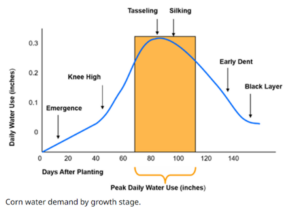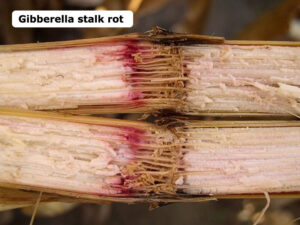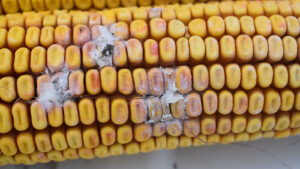Corn Facts: Drought and Harvest 2023

Drought conditions seriously threatened the 2023 grain corn crop in Manitoba. From planting until mid-September, many local fields remained depleted of adequate moisture to support good corn growth and development. As harvest occurs, it is easy to see where the drought impacted yields the most and where crops were graced with timely rains and have succeeded in yielding well.
The following are some facts that help tell the story of 2023 and why some fields were affected more than others:
- Nodal root development and functionality is reliant on soil moisture. At a shallow depth of 0.75 inches, if soil moisture is not available, the roots cannot properly establish, extract soil water or nutrients, or support upright growth of the corn plant.
- Corn leaves roll and appear pineapple- or onion-like in response to heat and drought. This decreases the surface area exposed to sunlight and reduces transpiration. Unfortunately, it also reduces photosynthetic activity in the plant, which impacts both maturity and yield.
- Kernel rows per ear have been said to be determined by V6. Number of rows is determined more by genetics than by environment.
- Kernels per row are determined from about V7 to a week prior to silking. This development is vulnerable to environmental stresses.

Figure 1. Corn water demand by growth stage.
Credit: Golden Harvest Seeds.
- Drought stress has a major impact during the V13 to silking (R1) stages of corn development. Water demand is at its peak during this time, so drought and heat stress negatively impact reproduction.
- Silks initiate elongation from the kernels around seven days prior to silking. Drought stress can slow elongation, delaying silk emergence or even causing failure of silks to emerge from the husk. Successful emergence of silks is then threatened by moisture and heat stress, which may desiccate silks and make them unviable to pollen shed.
- Adversely, drought stress speeds up pollen shed. Silk emergence and pollen shed may not sync, which means pollination potential is not met.
- Water demand remains high during the remainder of the reproductive stages and is required for proper grain development and fill.
- Drought stress can affect a corn plant’s ability to fill grain properly. As the plant begins to shut down and senesce, it is moving all its sugars and reserves to the grain to fill to its maximum. This process may be cut off by environmental factors, commonly including a severe frost.
- Prolonged environmental stress will lead to premature physiological maturity. The lack of moisture tells the plant to go into survival mode and fill grain with its remaining energy and reserves (mentioned above). This enables the plant to shut down from the ground up and eventually reach R6 (physiological maturity). The grain begins to dry down from this point on.
- Stalk diseases may be present, regardless of drought conditions during the growing season. Harvest affected fields first to avoid heavy winds and lodging losses.

Gibberella stalk rot on corn stalk.
Credit: Pioneer.
- Ear moulds may be present, regardless of drought conditions during the growing season. Harvest affected fields first to avoid spread of disease on cobs and quality concerns.

Fusarium Ear Mould.
REFERENCES:
- Corny News Network (Purdue): Corn Responses to Drought Stress
- Minnesota Crop News: Early Season Drought Effects on Corn and Soybean
- Purdue University: Drought and Heat Stress Effects on Corn Pollination
- Golden Harvest Seeds: Effects of Drought on Corn Plants
